 E-mail:mery@ntl-bearing.com
E-mail:mery@ntl-bearing.com
Time: 26th Feb 2024 Click:132 seen
For bearings, lubrication is an important issue affecting their function.
The suitability of lubrication or lubricant will greatly affect the life of the bearing.

1. Lubricant selection
The core of bearing lubrication lies in selecting the appropriate lubricant. For most applications, mineral oil is preferred because of its good viscosity-temperature properties and oxidation resistance. However, for high temperatures or special environments, higher-grade lubricants may be required, such as synthetic oils or special compound oils.
2. Lubrication method
There are many ways to lubricate bearings, the most common ones are oil lubrication and grease lubrication. Oil lubrication is injected into the bearings regularly through an oil pump, while grease lubrication is filled with grease into the bearings. Which method to choose mainly depends on the working conditions, such as temperature, speed and environment.
3. Lubrication cycle and amount
The lubrication cycle refers to the frequency of adding lubricant, which is usually determined based on the working time and mileage of the bearing. Lubrication quantity refers to the amount of lubricant added each time and needs to be precisely controlled to avoid too much or too little.
4. Lubrication device
To ensure that the bearings are properly lubricated, a complete lubrication system is required. This includes lubricant reservoirs, pumps, pipes and distributors. These devices should be maintained regularly to ensure proper operation.
5. Lubrication testing and monitoring
An effective lubrication monitoring system is essential. The working status of the bearings can be monitored in real time through temperature sensors, oil level sensors and vibration monitors. This data can help predict potential problems and take preventive measures.
6. Maintenance and replacement
Maintenance of bearing lubrication systems includes regular cleaning and replacement of worn parts. In addition, lubricants should also be changed regularly to ensure their performance. For critical equipment, it is recommended to work with the manufacturer or an expert to determine an appropriate maintenance schedule.
7. Consideration of environmental factors
Different environmental conditions may affect the lubrication effect of bearings. For example, high temperatures and humidity can accelerate lubricant deterioration, while dust and contaminants can clog lubrication systems. Therefore, an appropriate lubrication strategy needs to be selected based on the specific working environment.